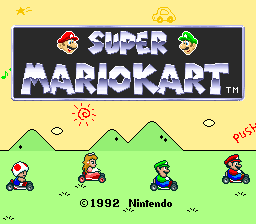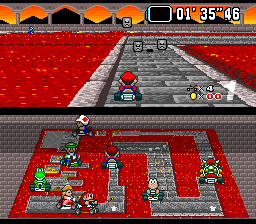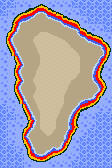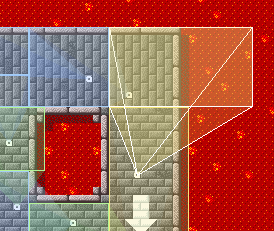Super Mario Kart
| Super Mario Kart |
|---|
|
Developer:
Nintendo EAD
|
Do Zrobienia:
|
}}
To do:
|
Super Mario Kart to zwariowana gra wyścigowa z Mario, Luigim, Yoshim i wieloma innymi postaciami z uniwersum Mario, która z grubsza rozpoczęła cały trend na „wyścigi maskotek”.
Contents
- 1 Podstrony
- 2 Tryb Debugowania
- 3 Nieużywane Kafelki
- 4 Niewykorzystane Funkcje Kafelków
- 5 Nieużywany Obiekt
- 6 Więcej Nieużywanych Grafik
- 7 Unused Track Colors
- 8 Nieużywane Palety Tła
- 9 Unused Track Tile Types
- 10 Oddities
- 11 Różnice Regionalne
- 12 Zmiany Virtual Console
Podstrony
| Development Info (untranslated) |
| Prototype Info (untranslated) |
| Prerelease Info |
| Notes (untranslated) |
| Bugs (untranslated) |
Tryb Debugowania
Dostęp do wielu debugowych funkcji można uzyskać kodem Pro Action Replay 7E1F06??, gdzie "??" zamienia się na:
- 04 — Wciśnięcie L umieszcza cię na ostatnim okrążeniu
- 08 — Gra crashuje na początku wyścigu
- 10 — Debugger przedmiotów. Wciśnięcie niektórych przycisków pozwala na natychmiastowe użycie przedmiotu:
- L — Zielona Muszla
- R — Czerwona Muszla
- A — Grzyb
- X — Gwiazdka
- Y — Pióro
- Select — Banan
- Y + Góra — Piorun
- Y + Down — Boo
- 40 — Wyścig natychmiastowo się rozpoczyna
- 80 — Wskaźnik użycia CPU
Więcej niż jedna funkcja debugująca może być użyta w tym samym czasie przez dodanie bajtów powyżej razem (np. wpisanie 14 zamiast "??" umożliwi i wciśnięcie L by pominąć do ostatniego okrążenia, i debugger przedmiotów).
Nieużywane Kafelki
Nieużywany Blok Mario Circuit
Ten blok można znaleźć w zestawie klocków z toru Mario Circuit. Działa jak droga, a nie jak normalny blok, jeśli zostanie umieszczony na torze za pomocą edytora.
Nieużywana Moneta Rainbow Road
Alternatywna wersja monety z Rainbow Road, która działa jak droga, a nie jak zwykła moneta.
Można ją również znaleźć w plikach źródłowych, gdzie we wczesnych zestawach klocków zajmowała miejsce grafiki monety.
Co ciekawe, znajduje się na początku zestawu klocków wśród grafik głównego toru, podczas gdy obiekty takie jak pola przedmiotów, paski skoku i sama normalna moneta są zawsze na końcu zestawu klocków, więc może to być coś innego i być częścią głównego toru. Albo po prostu była tam trzymana przez pomyłkę.
Ma też trochę blasku, w przeciwieństwie do używanej monety.
A different looking dirt tile. Unlike the other used dirt tiles, this acts like the snow from Vanilla Lake; it has a different sound and doesn't makes you too slow when driving over it.
An unused piece of a bumper. This tile was meant to extend the diagonal bumper that runs from top right to bottom left, but only a short version of it was used.
It was used in the April prototype for both Choco Island 2 and the scrapped Choco Island 3 track.
Donut Plains Unused Corner Tiles
Unused corner tiles meant for the edge of the grass. Only the tile with the corner being on the down right was used.
Ghost Valley Unused Plank Pieces
Unused edge pieces meant for the diagonal planks.
These were used in the April prototype in Ghost Valley 1.
Vanilla Lake Unused Tiles
A road tile with a single pixel, a narrow piece of the lake and a duplicate of the water tile that doesn't animate when placed on the track.
Niewykorzystane Funkcje Kafelków
W każdym motywie toru znajdują się grafiki pól przedmiotów, monet, Zipperów, ale można tam również znaleźć wyciek oleju. Używa własnej unikalnej palety, która jest inna dla każdego motywu toru, aby dopasować się do niego.
Wyciek Oleju
Plama oleju jest ładowana w każdym motywie toru, jednak jest używany tylko w torze Mario Circuit. Jego paleta jest zmieniana dla każdego motywu toru, aby pasował do danego toru (z wyjątkiem Rainbow Road).
Istnieje również kilka dodatkowych szczegółów wokół plamy oleju, które wyglądają jak brud, pasujące do Donut Plains lub Choco Island. Tego nie widać w motywie Mario Circuit, ponieważ brud używa tego samego koloru co droga.
Układy płytek są w tej kolejności: Donut Plains, Ghost Valley, Bowser's Castle, Choco Island, Koopa Beach, Vanilla Lake i Rainbow Road.
Plamę oleju z Choco Island można zobaczyć w Kwietniowyk prototypie gdzie znajduje się na każdym torze Choco Island.
Zipper
Podobnie jak Plama Oleju, Zipper ma unikalną paletę pasującą do każdego motywu toru. Jednak niektóre tory w ogóle nie używają Zipperów, więc palety kolorów pozostają niewykorzystane.
Układy płytek są w tej kolejności: Donut Plains, Choco Island, Koopa Beach, Vanilla Lake i Rainbow Road.
Zipper Koopa Beach można zobaczyć w prototyp kwietnia, gdzie znajduje się na obu torach Koopa Beach.
Nieużywany Obiekt
Obiekty składają się z zestawu płytek, które są umieszczane na torze i nie są widoczne w próbach czasowych. Przykładem są pola przedmiotów, plamy ropy i monety.
Jest jednak niewykorzystany obiekt składający się z 4 kolorowych klocków. Został użyty w Majowym prototypie, aby zablokować ścieżkę w Bowser Castle 3.
According to the debug menus used in various protoypes, this object is called "KABE" which means "WALL" in japanese.
Więcej Nieużywanych Grafik
Nieużywany Wierzchołek Drzewa
Mniejszy wierzchołek drzewa, przeznaczony do tła Mario Circuit.
Wykrzyknik
| Nieużywane | Używany |
|---|---|
Alternatywna wersja dużego wykrzyknika, który ma w rzeczywistości więcej szczegółów niż używany.
Nieużywana Czcionka
Znajduje się wśród grafik magazynu przedmiotów i numerów czasu wyścigu.
Najprawdopodobniej używany do celów debugowania, gdy gra była jeszcze w fazie rozwoju.
Unused Track Colors
Koopa Beach
The first palette of Koopa Beach features 12 unused colors, only 4 colors are used by one sand tile and the deep water tile. It seems to be an early copy of the mainly used second palette and overides the animated waterwave colors with these ones when used. This was possibly used by the track designers to place the animated tiles correctly.
| Used | Unused |
|---|---|
It also contains early colors for the bushes.
Ghost Valley
| Used | Unused |
|---|---|
The second palette features many unused colors including duplicates and brighter colors for the wood planks and the frail blocks. Only the starting line uses two colors of this palette.
Rainbow Road
| Used | Mockups with unused colors added. |
|---|---|
Rainbow Road has a bunch of unused colors for the colorful tiles. Each tile only uses 2 colors but there are 3 for each.
Nieużywane Palety Tła
| Do Zrobienia: Jest ich więcej. |
Tła mają 2 zarezerwowane rzędy palet, jeden dla pierwszego planu i jeden dla warstwy tylnej. Każdy wiersz ma cztery zestawy palet składające się z czterech kolorów (jeden to kolor przezroczysty) dla grafiki tła. Istnieją jednak tła, które nie wykorzystują wszystkich zestawów palet, przez co są nieużywane.
Użyto tylko jednej palety. Zauważ, że czwarta paleta używa czerwonych kolorów, może dla animacji porzuconej lawy?
Do pysznych czekoladowych gór użyto tylko jednej palety.
Nieco ciemniejsza paleta, która mogłaby nadać niektórym górom większy kontrast. Trzecia i czwarta paleta są takie same jak nieużywana paleta Mario Circuit (najprawdopodobniej resztki).
Tak samo jak powyżej, mogło to nadać niektórym chmurom większy kontrast.
Here are some background layers with their full size.
Mario Circuit
Donut Plains
Ghost Valley
Bowser's Castle
Choco Island
Unused Track Tile Types
| To do: There are more. |
Each track tile has an ID that determines how the tile will act (Road, Block, Lava, etc.). Besides some unused duplicates, some new and some unused variants can be found as well:
| ID | Description |
|---|---|
| 04 | Road, but you sink one pixel when driving on it. |
| 2E | Same as 04, but it stops your drift and items "die" when it comes in contact with it. |
| 32 | A strange deep water tile. Once you sink in it, you will jump out immediately, which leads to a permanent in and out jumping. |
| 2A, 3A | Jumpbar variant, items "die" when it comes in contact with it. |
| 2C, 3C | Choco Island bumper variant, items "die" when it comes in contact with it. |
| 88 | Variant of the destroyable ice and falling frail blocks, but this makes the normal wall crash sound when touched. |
Oddities
Bowser's Castle 2 Checkpoint Zone Oddity
In Bowser's Castle 2, the Checkpoint/AI data shows a zone at the middle-right side of the track that extrudes into the lava that is all that remains of a horizontal STOP seen in earlier iterations of the track.
Object Zone Oddity
The track's hazards like pipes, Monty Moles and more, are divided into groups, each with a zone. When entering a zone, its object group becomes visible. However, Mario Circuit 1 and Choco Island 1 have 3 zones, even though they only use 2 object groups. The game is programmed that when being in a zone with no objects, it will automatically display the objects from the next zone.
Object Zones as shown in track editor Epic Edit:
| Mario Circuit 1 | Choco Island 1 |
|---|---|
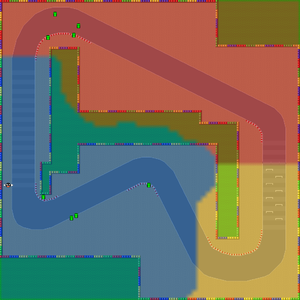 |
 |
Choco Island Finish Line
The finish lines seen in the Choco Island tracks are made of 2 tiles, despite both tiles having the same graphics (the second tile was given a blue color here to show the layout). This might suggests that the finish line was supposed to be more detailed like the starting brackets.
Bowser Castle Finish Line
Although it is barely noticeable, the finish line seen in the Bowser Castle tracks has some gray pixels on it. These pixels are in fact the first bits of the Titlescreen music which was housed in Bowser Castle's track graphics.
Choco Island Tile Animation Routine
Choco Island has its own tile animation routine although there's no data for animated tiles. This is a leftover when the choco mud was planned to move.
Różnice Regionalne
Całkiem sporo zmieniono między wersją japońską a międzynarodową, głównie w związku z cenzurą i drobnymi retuszami.
Ekran Tytułowy
| Japonia | Międzynarodowy |
|---|---|
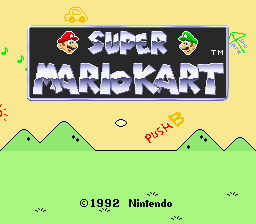 |
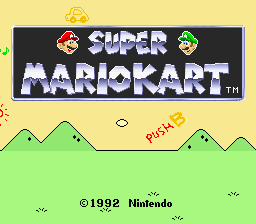 |
W japońskiej wersji grafika ekranu tytułowego ma mniejsze „O” i „E”, a litery nakładają się na siebie znacznie bardziej niż w wersji międzynarodowej. Japońskie napisy na ekranie tytułowym są bardzo podobne do napisów Super Mario Bros. 3, podczas gdy wersja międzynarodowa miała na celu nieco bardziej wyrafinowany wygląd. Ponadto „TM” znajduje się w innej pozycji, a pudełko, w którym znajduje się tytuł, zostało powiększone w wyniku tych zmian.
| Japonia |
|---|
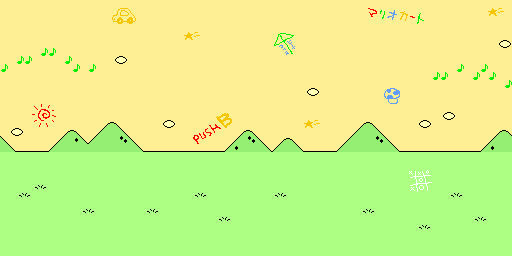 |
| Międzynarodowy |
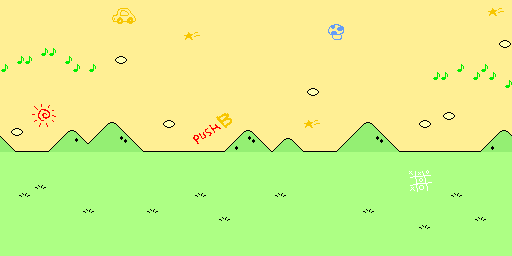 |
Tło używane na ekranie tytułowym w japońskiej wersji ma coś, co wydaje się być Ai-Ai Gasa (相合傘; przetłumaczone jako pod jednym parasolem) mówiące „Mario” i „Peach”, a także japoński tekst „Mario Kart”. Zostały one usunięte w wersji międzynarodowej z oczywistych powodów, a grzyb został przeniesiony, aby wypełnić część powstałej przestrzeni.
Ocenzurowane Animacje Zwycięstwa
W japońskiej wersji animacje zwycięstwa Bowsera i Princess Peach przedstawiają ich pijących szampana. Polityka Nintendo of America w tamtym czasie nie pozwalała na przedstawianie picia w grach, więc animacje musiały zostać odpowiednio zmienione. Zmiany te zostały zachowane do wydania europejskiego.
| Japonia | Międzynarodowy |
|---|---|
 |
 |
Zwycięska poza Bowsera pierwotnie pokazywała, jak pije szampana. Po prostu szczęśliwie pozuje w międzynarodowych wersjach.
| Japonia | Międzynarodowy |
|---|---|
W japońskiej wersji Księżniczka Peach delikatnie popija szampana, chociaż cieniowanie na jej twarzy mówi, że może już być pijana. W wersjach międzynarodowych podrzuca go w powietrze.
Donkey Kong Jr.
| International | Europe |
|---|---|
 |
 |
While Donkey Kong Jr. juggles his champagne beads wildly in the international versions, he only swings them up and down in the European version. Perhaps to prevent them from shattering on the floor?
Some of the prototypes also feature the European animation.
Yoshi
| Japonia i Europa |
|---|
 |
| USA |
 |
Kilka sprite'ów Yoshiego zostało poprawionych w wersji amerykańskiej, zyskując grubszą głowę. Zmieniono go jednak z powrotem na japoński projekt w wersji europejskiej.
Co ciekawe, grafika Yoshiego zastosowana w amerykańskiej wersji bardziej przypomina tę z niezrzuconego prototypu niż wersje europejska i japońska, choć ta ostatnia została wydana jako pierwsza.
2 Player Results Font
The japanese version uses its own roundy font for the Match Race and Battle Mode results screen, while the international version uses the same font as all the other text in that size. There was also a kanji next to the win/loss totals, that was removed in favor of "W" and "L" column headings.
| Japan | International |
|---|---|
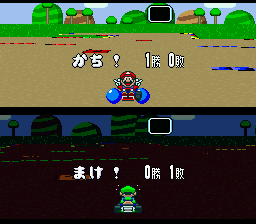 |
 |
Some of the roundy font (like the exclamation mark) can still be found in the international versions, unused.
Ukryta Funkcja „Odblokuj Special Cup”
Japońska wersja odtwarza dźwięk Boo po odblokowaniu specjalnego pucharu za pomocą kodu L, R, L, R, L, L, R, R, A w menu próby czasowej, podczas gdy wersja międzynarodowa nie.
Turbo Start
Probably due to the conversion from 60 to 50 FPS, the turbo start is slightly different between the European and the international version.
In the international version, you have to hold down the accelerator shortly after the first light sounds, while in the European version you have to hold it down shortly before the second light sounds.
Spalenie Silnika
Twój gokart w wersji amerykańskiej pali się krócej niż w innych wersjach, gdy nie uda się uruchomić turbo na początku wyścigu.
Replay Text
The Japanese version shows a flashing text while the replay is playing while in the international versions not, which can be seen here. The text, "リプレイ", translates to "Replay."
Ghost Saving
In the Japanese version the ghost saving button combo is different. After a Time Trial race at the options menu hold L, R, Y and press X to save a ghost in the International versions. In the Japanese version it is required to press A instead of X. It also displays the text "バックアップラムにゴーストをセーブしました" (which translates to "Saved ghost (data) to the backup RAM") in the bottom map while saving; the international versions displays nothing.
The game also ask you if you want to play with the recorded ghost before playing: the text displayed is "バックアップラムから ゴーストをロードしますか?", which translates to: "Do you want to load the ghost (data) from the backup RAM?". In the international versions, you don't get asked; instead, you need to hold either L or R button when starting a race.
Course Names
Some tracks from the japanese version have slightly different names.
| Japanese | International |
|---|---|
| Donut Plains Course | Donut Plains |
| Ghost Swamp Course | Ghost Valley |
| Koopa Castle Course | Bowser Castle |
| Chocolate Island Course | Choco Island |
| Nokonoko Beach Course | Koopa Beach |
| Vanilla Lake Course | Vanilla Lake |
Driver Names
Back then, Princess Peach was still known as Princess Toadstool or just as the Princess outside of Japan.
| Japanese | International |
|---|---|
| Peach | Princess |
| Koopa | Bowser |
| Nokonoko | Koopa |
| Kinopio | Toad |
European Version Changes
The European version fixes a glitch in Match Race and Battle Mode, where the loser could still drive when the race is over.
Zmiany Virtual Console
Błysk z użyciem gwiazdy i błyskawicy został stonowany, aby uniknąć ryzyka napadów padaczki.
Cleanup > Pages missing developer references
Cleanup > Pages missing publisher references
Cleanup > To do
Games > Games by content > Games with debugging functions
Games > Games by content > Games with regional differences
Games > Games by content > Games with revisional differences
Games > Games by content > Games with unused graphics
Games > Games by developer > Games developed by Nintendo > Games developed by Nintendo EPD > Games developed by Nintendo EAD
Games > Games by publisher > Games published by Nintendo
Games > Games by series > Mario series
